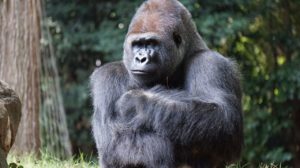Welcome to this article about the gorilla! Gorillas are impressive primates of the Great Ape family who share a remarkable similarity to humans. In fact, they are considered our closest living relatives in the animal kingdom. Due to this, they have a high level of intelligence compared to most primates. Join us as we explore some facts about the gorillas!

Scientific and Physical Characteristics
- Gorillas belong to the genus Gorilla and can be divided into two particular species: the eastern gorillas (Gorilla beringei) and the western gorillas (Gorilla gorilla). Each of these species have around two subspecies (such as the eastern/western lowland gorilla and the mountain gorilla).
- They are the closest living relatives of humans, along with the chimpanzees. On average, the human genetic code differs only by around 1.5% from that of the gorillas!
- They are the largest members of the primate family. Adult males can grow between 1.4 to 1.8m in height with a weight of 140kg, while females can grow up to 1.5m at the most and weigh half as much as the males.
- Gorillas have a mandible (lower jaw) that protrudes further in front of the maxilla (upper jaw).
- They have a characteristic black fur coat with variations depending on the species. For example, the eastern gorillas are more dark-colored than the western gorillas.
- The largest adult male of a group is known as the ‘silverback’ due to the presence of silver fur on their back and larger canines.
- Gorillas that live in the lowland forests tend to be more slender with less bodyweight compared to the heftier mountain gorillas.
- Similar to humans, gorillas are the only other primate species who have a ‘fingerprint’ that is unique to each individual.
Gorilla Habitat and Distribution
- The gorillas are concentrated in Central Africa and the two species are separated by the Congo River and the related tributaries. As their names suggest, the Western gorilla is found in parts of the west while the Eastern gorilla is obviously located in the east of Central Africa.
- The habitats of gorillas vary between the subspecies. Mountain gorillas are located in the forests of the mountain regions while the lowland gorillas are found at forests of a lower elevation.
- In terms of their habitats, gorillas create nesting sites which are mostly built on the ground although a few tree nests are created as well.
- The nests are created with a simple cluster of branches and twigs and are usually around 5 feet in diameter.
- The building of a nest is considered as a good example of the brilliant use of tools by gorillas.
- Mountain gorillas have a home range of around 3-15km2 while the lowland gorillas have a range of around 3-6.5km2.
Gorilla Diet
- Gorillas are fully herbivorous primates.
- The mountain gorillas rely on foliage such as shoots, leaves and branches of plants. Fruit is eaten at a low quantity.
- The eastern lowland gorillas have a more diverse diet consisting of both plants and fruits. This will also depend on the season at which the food is eaten. Due to the lack of fruit, lowland gorillas will travel up to 1.5 miles in search of more food.
- Due to the bulk of the water present in the succulent vegetation they eat and the constant hydration they receive from this, gorillas rarely drink any more water.
Gorilla Behavior
- A gorilla has a life expectancy of between 35 to 40 years. The oldest gorilla to ever exist was Colo, a female western gorilla who lived until she turned 60 years of age!
- Gorillas are highly intelligent primates. They are noted for their usage of tools in the wild. For example, they can use rocks to smash open nuts and have been observed to use support for ‘fishing’ for herbs from swamps.
- One of the most famous gorillas was called Koko, a female western gorilla who was born in captivity. Koko learned how to communicate using the American Sign Language and had an active vocabulary of around 1000 words while understanding twice as many words in English.
- Gorillas have a complex social structure. They live in groups known as ‘troops’ which consist of one adult silverback, several adult females and their young ones.
- The silverback is responsible for leading the troops, resolving conflict, making decisions, leading the group toward sites of food and protection from predators amongst other duties. A silverback also has backup consisting of juvenile males known as ‘blackbacks’.
- A troop is always closely knit with each member relying on each other for support.
- Aggressive behaviors between gorillas may occur for dominance and territory.
- All species of gorillas are considered to be ‘critically endangered’ due to the effects of habitat loss through deforestation and poaching. At present, just over 100,000 gorillas are found in the wild with around 4000 raised in captivity.
- Conservation projects such as the Great Apes Survival Project are currently focusing on controlling this decline.
I hope that you enjoyed this fact about gorillas. For more information about other animals, visit animal fact page!
